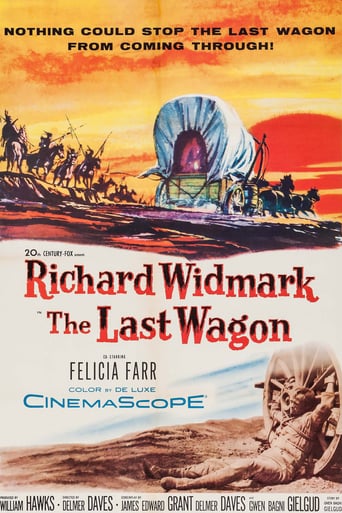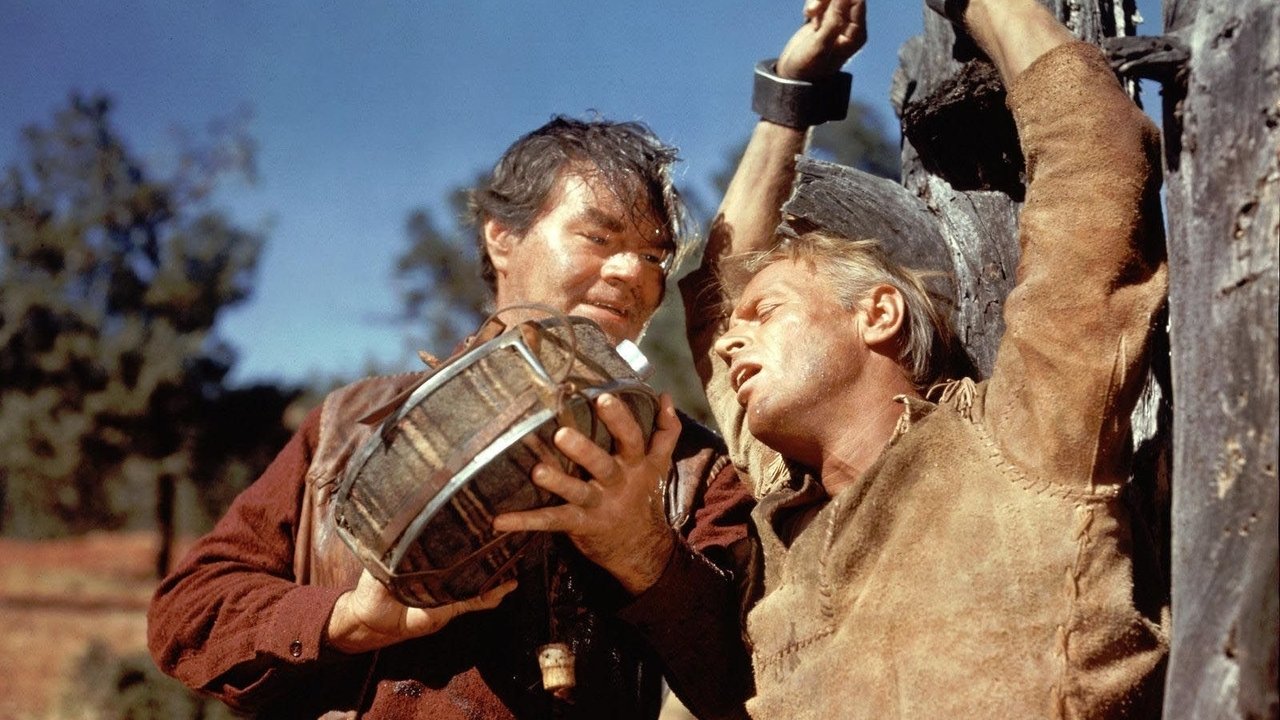agitator76
Richard Widmark's costume does indeed show evidence of Comanche Todd being shot in the shoulder at the beginning of the movie: a tear and powder burn. Very clear when watching the movie on an IPad.
Wuchak
I caught "The Last Wagon" for the first time on TV many moons ago. All I remember is that it kicked axx from beginning to end. Seeing it again last night, I'm happy to report that this 1956 Western holds up well despite the dated score.THE STORY: Richard Widmark stars as Comanche Todd, a white man raised by Comanches and under arrest for murder. Deep in hostile Apache territory he soon finds himself the leader of a small group of youths from a wagon train. Will they make it out alive? And, even if they do, can Todd escape the sentence of death-by-hanging? First of all, this film is gorgeous to look at -- shot on location in Sedona, Arizona, at the mouth of Oak Creek Canyon.Secondly, not only is the plot excellent, so are the characters, cast and everything else. The film successfully takes you back to the late 1800s and gives a good glimpse of what it must have been like to travel out West during that time.Felicia Farr and Susan Kohner stand out in the supporting cast; both are incredibly beautiful. Each youth has his/her issue(s) and grows much as a result of their experiences with Comanche Todd and the dire situation. For instance, Susan (Jolie) is ashamed that she's half-Indian but Todd teaches her to be proud of who and what she is. Others hate Todd for being an "injun lover" but later see the error of their ways. Todd himself is lost in in a fog of bitterness & revenge but a new potential family is thrown in his lap. Can he get over his disillusionment to see the blessing in his current situation? This is just a taste of the character arcs addressed in the story.Stop the presses! Christianity and Christians are actually portrayed in a positive light -- amazing! Yet so are the beliefs/practices of the Natives. The film does an outstanding job of taking the middle road with the settlers and the natives. Not to mention, the Indians are portrayed realistically, unlike many 50's Westerns where you just roll your eyes at their silly depiction.Aside from the dated score (which isn't bad, just dated), the only negative I can cite would be the way in which the conflict with the Apaches is concluded. But the film makes up for it with a powerful end-commentary on the nature of universal justice.The DVD features both the widescreen and fullscreen versions.MY GRADE: A
weezeralfalfa
Suspenseful Native American-settler conflict story, mostly shot in color in the spectacular backdrop of Oak Creek Canyon, AZ. Widmark excels as blue-eyed Caucasian 'Comanche' Todd who has, through circumstances, become part Comanche. His Comanche wife and their children were murdered by 4 white men, one of whom is a sheriff. In fact, Todd was also left for dead. He tracked and killed 3 of the brothers, only to be wounded and captured by the remaining sheriff brother, who drags him at the end of a rope toward his trial. They meet a wagon train, where a few take exception to his savage treatment, while the others are indifferent or hostile. The sheriff continues to prove too mean for some, and Todd takes the opportunity to kill him during a scuffle with others. While a few are away at a swimming hole at night, avenging Apache's massacre the remaining people, with only Todd, left for dead, surviving. He offers to try to lead the survivors out of their dire situation. Eventually, a cavalry detachment arrives, looking for him, and his strategy(involving the unexplained discovery of much dynamite) saves all from slaughter by the Apaches.I am very surprised that Todd's strong philosophical defense at his trial is hardly mentioned in any of the reviews I have read. In fact, it serves as a strong statement of the occasional justification for vigilante justice in a time and place where formal law enforcement was weak, where relations between Caucasians and Native Americans were typically hostile, and where Native Americans typically were given no justice by the formal justice systems. Clearly, the ex-Union general who presided over this case formally considered all the relevant murders to be non-military-related criminal cases, whereas Todd considered them to be analogous to the killing of Union and Confederate soldiers and civilians by each other. In the contemporary US, gangland killings would be analogous. The legal systems don't recognize that these gangs are, de facto, at war with each other. Of course, a major difference is that strong law enforcement systems are operating in the relevant areas, in contrast to Todd's situation. Just as profound is the question of whether Todd's subsequent heroics should be relevant to his sentencing.(The judge initially discounted this, but the testimony of others eventually proved the deciding factor in his sentencing.) Should the overall apparent character of the accused be a major factor in sentencing? If the accused has saved the life of one or 100 people in the near or distant past, should that act as a counterweight to any criminal acts? Very important question(especially relevant today in the medical, fire, police and rescue fields).Some aspects of the story don't make sense to me. I've already mentioned the unexplained sudden appearance of lots of dynamite. Widmark apparently planted dynamite in all the wagons, so that they all blew up to scare the Apache away, the settlers losing everything. Yet, the wagons are back, rolling along, in the fadeout!.... Why are the cavalry looking for Todd as a murderer, when there were no surviving witnesses to his murder of 3 of the brothers, which were committed in the wilderness? Why was extraordinarily beautiful Felicia Farr's character traveling to the dangerous frontier to marry a man she had never met?
MartinHafer
This film begins with Richard Widmark being chased by a posse. In the process, Widmark kills several of the deputies until he is ultimately captured. The sheriff (along with Widmark) soon meets up with a wagon train and tags along with them until he can get his prisoner back to town for a proper hanging. As for why Widmark did all these nasty murders, he is supposedly part Comanche (he sure doesn't look it--that's because he was a white orphan raised by the tribe) and has a total disregard for society--and somehow this entitles him to kill with abandon.Problems soon develop with the settlers. They are devout people and can't stand the way the sheriff takes pleasure in tormenting Widmark (who is now handcuffed to a wagon wheel). What happens next with Widmark and the sheriff is something you'll need to see for yourself.Soon another parallel story begins as well. One of the ladies in the wagon train is angry because her father was previously married to an American-Indian and she has a half-sister as a result. There is obviously much hatred of the 'half-breed' sister and the racist feelings the white sister feels is a parallel to the story of Widmark. Occasionally this tension seems a bit overdone--especially since you'd think the angry white sister would have come to terms with her half-sister and the white settlers would get tired of using words like 'savage' so much. Subtle its message ain't and the one young lady in particular plays a character too unlikable and annoying to be real--the one and only real deficit in an otherwise good film.Unfortunately for the wagon train, the land they eventually enter is Indian land. Soon, it appears that the Indians are angry about their land being invaded and it appears that all of the settlers' lives are about to be snuffed. At this point, the tables are turned and it's up to the cold-blooded killer, Widmark, to save the day--escorting the survivors to safety and teaching them to live off the land like natives.By the way, as you watch Widmark chained to the wagon wheel and doing some stunts as well while connected to the wheel, you are impressed by how much he was willing to do for this role. Occasionally, you assume it's a stuntman doing some of the scenes but in many cases it is clearly Widmark being tossed about in this very uncomfortable manner. What a guy...and what a good film.Overall, a very good film that is worth watching for its fine performance by Richard Widmark as well as an interesting and thought-provoking script. As I already said, the story isn't always subtle nor are a few of the characters, but it still is an earnest and enjoyable flick.


 AD
AD




